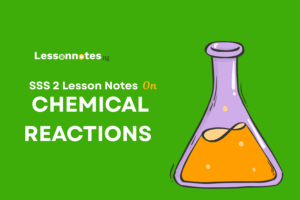Chemical Equilibruim SS2 Chemistry Lesson Note
Download Lesson NoteTopic: Chemical Equilibruim
Equilibrium can be defined as the state of a system where there is no observable or detectable change in the properties of the system concerning time. Examples of the system in equilibrium
- a balanced see-saw
- a saturated solution of NaCl
STATIC AND DYNAMIC EQUILIBRIUM
Static equilibrium is attained when a system in equilibrium is in a state of rest or stationary state.
An example of this is a balanced see-saw
Dynamic equilibrium can occur during a physical change or a reversible chemical change. Dynamic equilibrium involving a physical change is referred to as physical equilibrium while that involving a chemical change is a chemical equilibrium.
A system is said to be in a state of dynamic equilibrium when both the forward and backward reactions take place at the same rate. Example
N2O4(g) >< 2NO2(g)
EQUILIBRIUM IN REVERSIBLE REACTION
A reversible reaction proceeds in both forward and backward directions under suitable conditions.
For example:
NH4Cl(s) > NH3(g) + HCl(g)
A reversible reaction is said to be in dynamic equilibrium when both the forward and backward reactions are occurring at the same rate, thereby producing no net change in concentrations of the reactants or products.
PROPERTIES OF SYSTEM IN EQUILIBRIUM
- A chemical reaction at equilibrium is in a dynamic state with the rates of the forward and backward reactions being equal.
- The equilibrium position can be reached from reactants alone or product alone.
- For equilibrium to be established, the system must be closed.
FACTORS AFFECTING THE POSITION OF EQUILIBRIUM
The position of equilibrium depends on the following set of conditions:
- Temperature
- Concentration
- Pressure (for gasses)
Variation in any of these factors will upset the balance of the system and result in a shift in the position of the equilibrium. These factors and their effect on chemical systems in equilibrium were studied by Le Chatelier who formed Le Chatelier’s principle.
Le Chatelier’s principle states that if a chemical system is in equilibrium and one of the factors involved in the equilibrium is altered, the equilibrium position will shift to neutralize the effect of the change.
Importance Of Le Chatelier’s Principle In Chemical Industry
It helps to:
i. Define optimum conditions for the chemical process
ii. Reduce undesirable reversibility
iii. Predict the effect of altered factors on the equilibrium
- Effect Of Temperature
For an endothermic reaction, an increase in temperature shifts the position of equilibrium to the right. That is, the forward reaction is favoured while a decrease in temperature favours the backward reaction. The reverse is the case for exothermic reactions.
2. Effect Of Concentration
In a system of equilibrium, if the concentration of reactants is increased or the product decreased, the forward reaction will be favoured, that is; the equilibrium position shifts to the right. Also, if the concentration of the products is increased or the reactant is decreased, the backward reaction will be favoured, equilibrium position will shift to the left.
- Effect Of Pressure
The pressure of gas is proportional to the number of moles. An increase in the number of moles implies an increase in pressure and vice versa. If the forward reaction proceeds by decreasing in number of moles (pressure), an imposed increased pressure will favour the forward reaction. Reverse is the case if it proceeds by an increase in the number of moles (pressure). In other words, when high pressure is applied, equilibrium will shift to the side with a lesser number of moles while when low pressure is applied, equilibrium will shift to the side with a greater number of moles.
N2(g) + 3H2(g) > 2NH3(g)
1 mole 3 moles 2 moles
An increase in pressure favours forward reaction while a decrease in pressure favours backward reaction
- Effect Of Catalyst
A catalyst does not change (affect) the position of equilibrium. The addition of a catalyst, however, increases the rate of both forward and backward reactions by lowering the activation of energy of the reaction.
The equilibrium position is attained at a faster rate when a catalyst is present.
HABER PROCESS
Haber process is an industrial process for the manufacture of ammonia.
Ammonia, NH3, is an important chemical for the manufacture of fertilizers. During the process, the following equilibrium is established
N2(g) + 3H2(g) > 2NH3(g) H = -96KJmol-1
1 mole 3 moles 2 moles
1. Choice Of Temperature
Since the forward reaction is exothermic, Le Chatelier’s principle shows that the greatest yield of ammonia, NH3, would be obtained at low temperatures. However, if the temperature is too low, the time taken to reach equilibrium would be much. A temperature of 5000C gives a reasonable yield of ammonia.
- Choice Of Pressure
Since forward reaction leads to a decrease in the number of moles (pressure), Le Chatelier’s principle shows that a high yield of ammonia would be obtained at high pressure. The pressure of 25atm gives a satisfactory yield.
- Choice Of Catalyst
Iron is used as a catalyst in the Haber process. Iron is found to be effective in speeding up the rate at which equilibrium is reached. It is used in the form of small pellets which increase the surface area available for contact.
EQUILIBRIUM CONSTANT (K) AND LAW OF MASS ACTION
The law of mass action states that at constant temperature, the rate of reaction is proportional to the active masses of each of the reactants;
The active mass of the reactants is the concentration of the substance raised to the power of coefficient (number of moles) of that substance in the equation of reaction under study.
NOTE: Active mass = molar concentration x activity coefficient
In most reactions, the active masses of the reactant may be taken as their molar concentrations.
Example:
aA + bB products
Thus, r α [A]a and r α [B]b
where [ ] represents the concentration in mol dm-3
r α [A]a x [B]b
r = k [A]a [B]b
where k is called equilibrium constants
Applying the law to the reversible reaction represented by the equation below:
aA(aq) + bB(aq) cC(aq) + dD(aq)
Kc= [C]c [D]d
[A]a [B]b
Where Kc is called the equilibrium constant
For reactions involving gases, the equilibrium constant is expressed in terms of the partial pressures of the gases involved in the reaction.
Therefore, for the general gaseous reaction:
aA(g) + bB(g) >< cC(g) + dD(g)
Kp = PCc x PDd
PAa x PBb
Where Kp is the equilibrium constant for the gaseous reaction, PA, PB, PC and PD are partial pressures of gases A, B, C and D respectively.
NOTE: For a given reaction, concentrations of solids are ignored. A Kc or Kp value greater than one tells you that product formation is favoured at equilibrium; while a Kc or Kp value less than one tells you that reactant formation is favoured at equilibrium. A system in equilibrium has a Kc or Kp value equal to one.






















